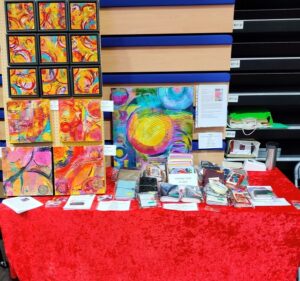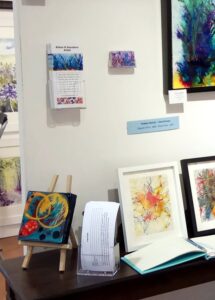An artist’s statement is a short, written piece about your artwork, your art practice and an opportunity to discuss briefly the thought process behind making your work.
If you are struggling to write one for yourself, my first suggestion is to go online and read as many different artist’s statements as you can to see if you find something which resonates with you. You will find that they are as varied and diverse as the artists who have produced them so there are no hard and fast rules. My comments here are my own suggestions and reflect my own practice but they should not be taken as gospel. 
If you are planning on entering art shows, competitions etc., the organisers will ask you to provide a statement, along with examples of your work. This statement can also be used on your website, in press releases and at exhibitions where the organisers want information about the artists whose works are on display. Depending on the event, you are likely to be asked for a statement perhaps with as few as 100 words, or maybe 200 or 500 words or with no restrictions. My advice is to start out by writing a 1,000 word statement which can then be edited down as necessary.
I store each of my versions in a separate file labelled 100 words, 200 words etc., so that if I need one in a hurry I can pull up the file and double check to make sure that it is suitable for the event I need it for. It is not unusual to have to make changes to bring the text up to date but it does make life easier overall.
An artist’s statement is a way of introducing your work, the motivation behind the work you make, the methodology you employ and/or your working practice. Its purpose is to give the reader an insight into your work, how you work, your methods and where your influences come from.
When writing your statement, use plain English whenever possible. If there is a particular concept or method which uses technical terms or jargon, explain it clearly remembering that although your audience may not be specialists in your field, they don’t want to be made to feel stupid, so keep it simple but informative.
Be honest about what you do and where you are in terms of your artistic journey: most people can see through over-inflated egos and grandiose claims. Explain why you make your work, where your influences have come from and where you see your work going in the future. Having a future vision also tells the reader (and, hopefully, prospective buyer?) that you are here to stay.
Stay focused on your work and don’t wander off into a philosophical debate. The statement is about you and your work and it should be written in the first person (i.e. from the I/me/my perspective).
The following list of suggestions provides questions you should be considering when producing your statement:
- Do you work in other media, too?
- What medium/media do you work with?
- Is there a crossover between the media you use?
- Why do you use this medium/media?
- Do you mix these media together? Why?
- Is one medium used for a specific type of work, what is the relationship here?
- Where do your ideas come from and how are they influenced by your chosen media?
- Are there any specific issues around the way you work? I have a friend who works with rust, so her summer is spent turning fabric and paper into rusted pieces which she spends the winter turning into wonderful artworks.
- Does your work have a message?
- Is your work influenced by something in particular, e.g. climate change, the war on plastics or is it the product itself?
The things you should not include in your artist statement are:
- Your working career as an artist or prior to being an artist;
- Your qualifications;
- Exhibitions in which you have taken part.
That information belongs in a CV or your artist’s biography (bio for short), which is a completely different document. Your bio should summarise noteworthy information about your art career and should always be written in the third person (i.e. S/he, they, their perspective).
The following information should be included in your bio:
- Your place of birth;
- Your current location;
- Your art education, i.e. self-taught or formal;
- When you first became interested in art;
- Your influences and where you draw your inspiration from;
- Your media and techniques and why you use them;
- Significant artists you have worked under (if appropriate);
- Awards and prizes you have won;
- Exhibitions in which you have taken part. List these in chronological order with the latest at the top of the list;
- Where your work is, countries in which you sell and collections you are included in, both public and private.
 You can include any TV, press coverage or critical reviews in your CV or bio and the document should also be posted on your website.
You can include any TV, press coverage or critical reviews in your CV or bio and the document should also be posted on your website.
Finally, if you are feeling overwhelmed by the thought of doing this or if you don’t feel that you could write this yourself, ask someone to do it for you. Most of us know people who have far better writing skills. I have someone who checks my written work for grammar and spelling and I have a backup person in the wings just in case there is a problem. These two are both far better in that area than I am and that’s fine. They get to feel useful, wanted, needed and sometimes superior to me, but I still get what I need; accurate documents which I am happy to share with anyone who is interested.
They will both have checked this blog too, so thank you both of you. XX
If you would like to join one of my classes in my purpose-built studio then either email me at alison@alisongsaunders.co.uk or head over to my website and check out the booking form for scheduled classes.
If you have enjoyed reading this post, please like and follow me and share it with people who you think might be interested. I am always looking for new artists to feature and if there is a subject you would like me to write about, I will be happy to consider it. Sharing, liking, and following my blogs increases the number of people the algorithm shows them to. Thank you in advance for supporting me this way.
